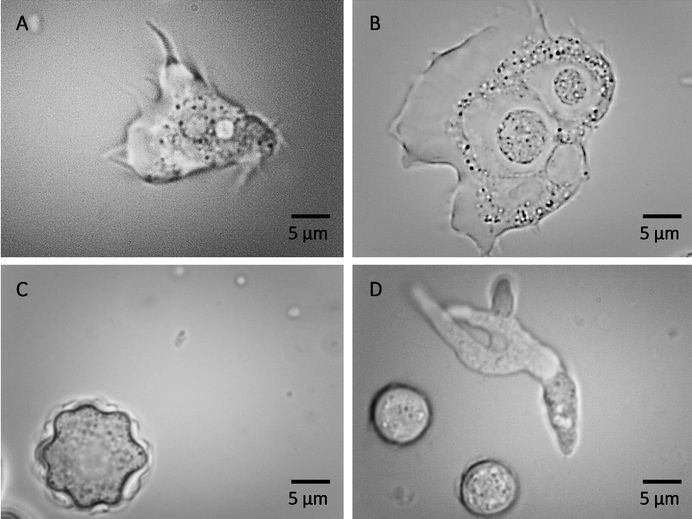Breakthrough in fighting Legionnaires’ disease
Research finds key connection with a ‘host’ microorganism in drinking water
Advertisement
A new study of domestic and hospital drinking water systems found Legionella in 41% of samples – with Flinders University researchers making a key connection between the pathogen’s co-existence with a ‘host’ microorganism in all samples tested.

Light microscopic images of trophozoites (active form; image A, B and D) and cysts (dormant form; image: C and D circular in shape) of Acanthamoeba (image A, B and C) and Vermamoeba vermiformis (image D) shown at 100 times magnification.
Flinders University
The study found Legionella bacteria “infect the amoeba host and then once inside these hosts are protected from disinfection strategies,” says Flinders University Associate Professor of Environmental Health Harriet Whiley, a co-author of the new journal article in Water Research.
Researchers tested for Legionella and its likely amoebae hosts in 140 samples of water or biofilm (the slime found on showerheads and end of faucets) to understand how the potentially dangerous bacterium colonises and proliferates in both domestic and hospital plumbing and poses a threat to human health.
Legionnaires' disease is a severe pneumonia-like infection that can be fatal. Globally the number of Legionnaires’ disease cases is increasing, with elderly and immunocompromised people at the highest risk.
“It is vital that we strive to improve the management of our water distribution systems, particularly in high risk setting such as hospitals, to protect vulnerable populations,” says Associate Professor Whiley, from the Flinders College of Science and Engineering.
“Having a better understanding of the relationships between these amoebae and Legionella is an important step in improving future water treatment processes aimed at controlling Legionella and preventing Legionnaires disease.”
L. pneumophilia is the main cause of Legionnaires' disease and is not transmitted from person to person but caused by inhalation or aspiration of contaminated water.
Maintenance and monitoring of water systems is a common preventive step to reduce public risk.
“To our knowledge, this is the first time the amoebae Allovahlkampfia and Stenamoeba have been demonstrated as hosts of L. pneumophila in Australian drinking water,” says Flinders University PhD candidate Muhammad Atif Nisar, who conducted the study.
The findings support the need further research to investigate the prevalence of Legionella as well as free-living amoebae in domestic and commercial water systems and to improve guidelines to better control water systems and safeguard the public health.
“Free-living amoebae are ubiquitous in the environment and cause both opportunistic and non-opportunistic infections in humans. Some amoebae are the natural reservoirs of opportunistic plumbing pathogens, such as Legionella pneumophila,” says Mr Atif Nisar.
“There is a need for future research to improve disinfection strategies against amoeba to reduce their colonisation within building drinking water systems.”
Up to 75% of the drinking water or biofilm samples tested positive for free-living amoebae. This included V. vermiformis which was present in 55% of samples and Acanthamoeba was present in 11%.
As well as being hosts for Legionella, Acanthamoeba and V. vermiformis are pathogens that can cause severe eye infections, with contact lens users and immunocompromised individuals at greatest risk.
The water samples were collected from showers and hand basins located in domestic houses and hospitals across New South Wales and South Australia.
These results demonstrate the importance of amoebae in engineered water systems, both as a pathogen and as a reservoir of Legionella.
“Future water management protocols should incorporate improved treatment strategies to control amoebae to reduce the risk to end-users,” adds Mr Atif Nisar.

















































